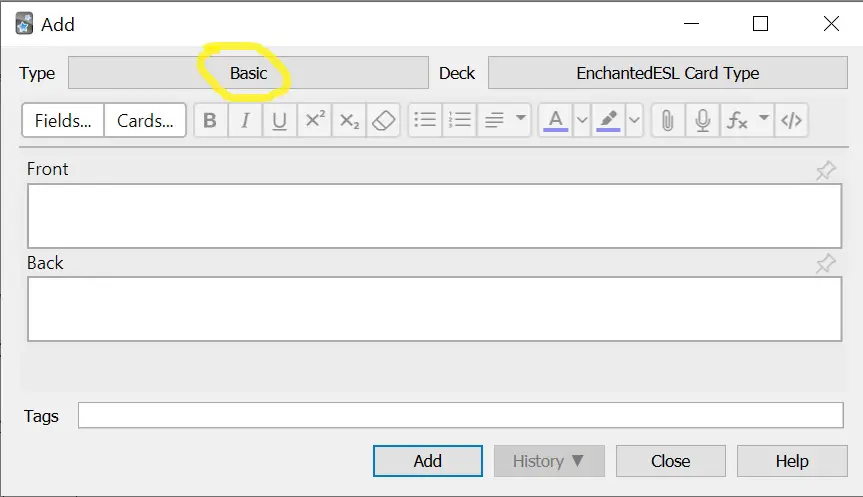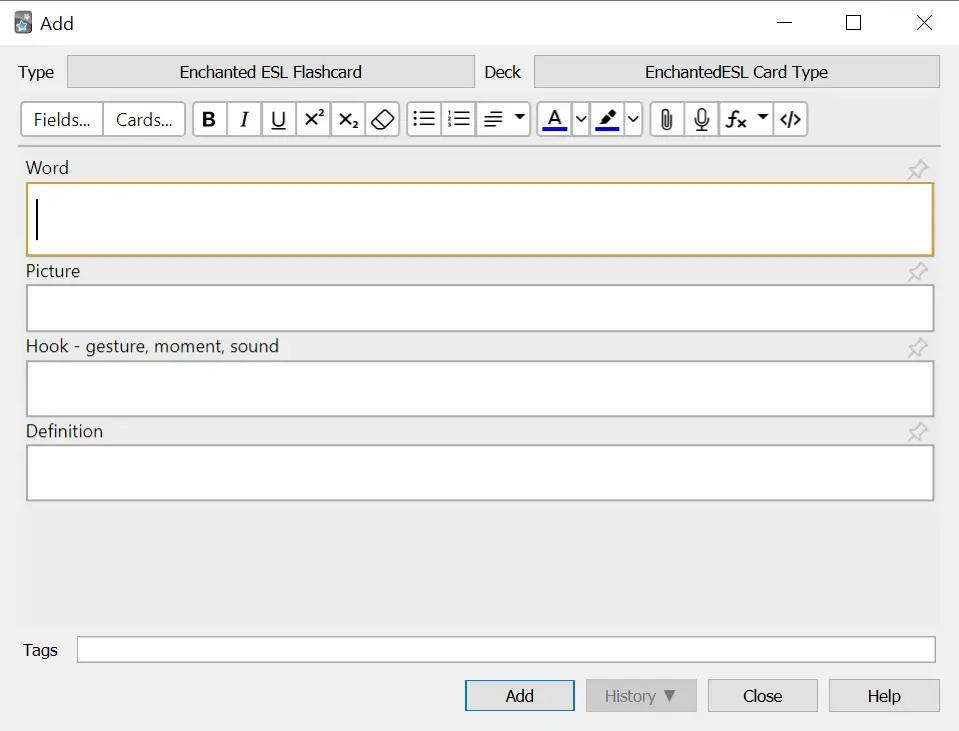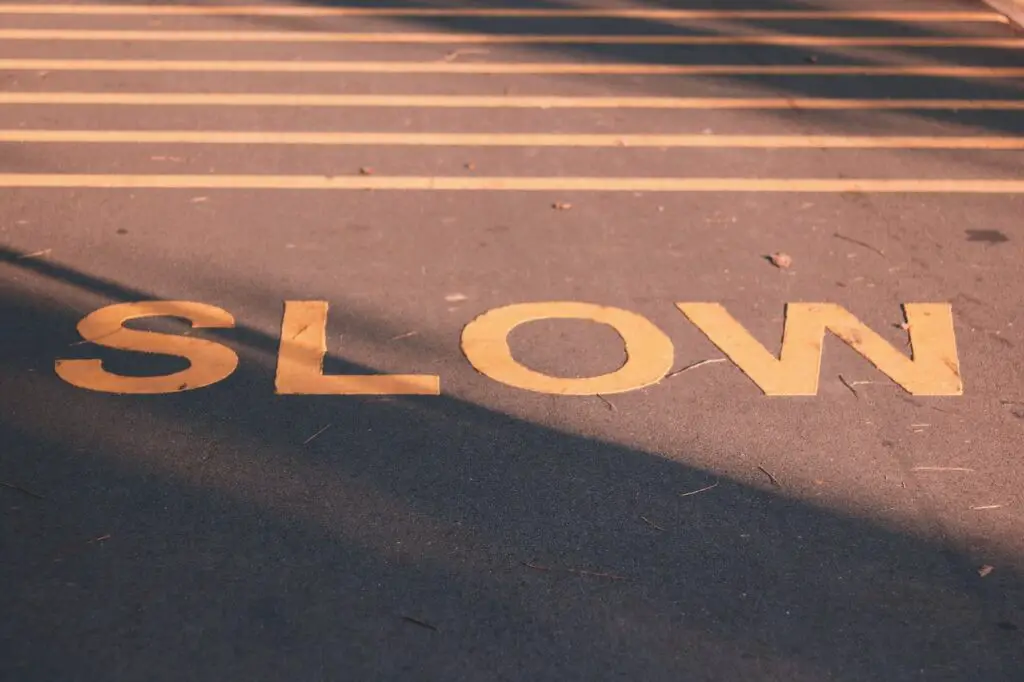At times, I despair at how far the EFL/ESL industry lags behind modern technology.
There are tools out there, such as spaced repetition apps, which can dramatically improve students’ retention of information both in the short and long term. Yet so few teachers know about them and even fewer use them!

In my Best Method to Improve EFL/ESL Students’ Vocabulary: 9 Steps, I show the three phases of vocab learning – acquisition, memorisation, and retention. Using spaced repetition is part of the last phase – retention.
In this article, I’ll explain what spaced repetition is, introduce the best app available (Anki), and share how to supercharge your EFL/ESL students’ vocab recall.
I’ve used this method successfully with many students, and found it vital in my own language learning. So without further ado, let’s get to it!
What is spaced repetition?
Spaced repetition is a long-term memorisation strategy which uses an algorithm to space intervals of repeated learning in the most efficient way. Often, flashcard apps automate the process. The idea is to extend the repetition intervals for words the learner finds easy, and reduce them for difficult words.
Imagine a student, let’s call her Alicia, is learning the English word “pineapple”.
On the first day, Alicia tries to remember it from a prompt (ideally a picture of a pineapple). If she gets it wrong, she’ll repeat it in the same session. If she continues getting it wrong, she keeps repeating it in that session until she gets it correct.

When she gets it correct, she’s done for the day. But the next day it’ll appear again. If she gets it right then, it’ll be four or five days until she next sees it. Right again? A couple of weeks until it shows up. Each time she gets it right, the interval increases according to an algorithm.
If she gets it wrong at any point, the process goes back to the start.
What are the benefits of using intervals?
Firstly, she’ll focus on what’s important. Instead of dedicating an equal amount of time to all words, easy and hard, the easy ones will appear less frequently because she already knows them. She’ll only focus on the vocab she needs to practice.
Secondly, a good algorithm predicts the moment she’s just about to forget the word. It can do this thanks to years of experimentation by algorithm designers.

A third advantage is the workload is light. Daily sessions are required, but each session will only last 5-10 minutes. A little every day is better than one big session.
This brings up one downside of spaced repetition. It requires a regular commitment. Creating the habit of daily practice is difficult, and many students will fail unless you provide support (something I’ll talk about later in the article).
Another drawback comes when you try to learn conceptual or complex information. Most spaced repetition methods rely on flashcards which cater best to questions with short, simple answers rather than multi-part questions and abstract ideas.
Spaced repetition is perfect for practicing vocabulary. In fact, language learners are probably the biggest users of spaced repetition, along with those studying for medical exams.
To learn more about spaced repetition, check out the video below from College Info Geek. Also, this study published in Frontiers in Psychology gives a more in-depth look.
But perhaps you’re thinking this might be too complicated to set up and manage – all those intervals and figuring out when the student will forget a word. Fear not, there’s an app for it.
What is Anki?
Anki is, in my opinion, the best spaced repetition app available right now. Plus, it’s FREE.
You can get to the Anki website here.
The app streamlines and automates the spaced repetition process, meaning you don’t have to think about intervals or algorithms at all. All you have to do is make the flashcards.
However, there’s a lot more to it than that. It boasts arguably the best algorithm out there, flexibility for using images, audio and cloze features as well as having thousands of add-ons for extra functionality.
To learn more about using images and sounds for vocab learning, see my articles: How to Use Images for Deep Vocab Memorisation in EFL/ESL and Sounds and Audio Hooks for Lasting Memorisation in EFL/ESL
And if you don’t fancy making the flashcards yourself, you can download thousands of pre-made decks on any subject. Beware, though, these vary in quality. I don’t recommend this option, as it’s much better to make custom decks that suit your students. Keep reading to learn how.
To get started using Anki, watch this tutorial video by ColeLangs.
Did I mention Anki was free? There are no pricing plans or upfront costs for anyone using the app on desktop, browser or Android devices. For some reason, you have to pay to get the iOS app. It’s about $25 (well worth it!). Alternatively, you can use the free browser version on your iPhone or iPad.
If you’re not convinced by Anki, take a look at my article comparing the major spaced repetition apps: Is There Anything Better Than Anki? 3 SRS Alternatives
How to use set up Anki for EFL/ESL classes
Now you’ve got Anki set up, you’re ready to create flashcards.
The default flashcards in Anki are basic. For our purposes, we need cards which have room for pictures, definitions and other extra information.
I made a card type which does exactly this. Download it for free by following this link.
Now, if you’ve followed the previous 6 steps in my Best Method to Improve EFL/ESL Students’ Vocabulary: 9 Steps, you’ll have a wealth of organically acquired and elicited vocabulary. You should also have accompanying pictures, physical hooks, audio hooks, and positive moments.
Not all these things are required for each word, but make sure you have at least two. If you don’t have any of them, go back and read the guides so you can get the best out of what’s coming next.
Open Anki and create a deck for your class. Then click “Add” to make a new flashcard. A window will open, like the one below.

Click the highlighted “Basic” button at the top. A new window will open, and you need to choose the Enchanted ESL Flashcard (which you can download from this link if you haven’t already). When you’ve done that, you’ll see this:

Fill in the fields with the appropriate information. You can drag and drop pictures from folders on your PC, or straight from Google Images.
Learn how to get the best photos by reading this article: How to Use Images for Deep Vocab Memorisation in EFL/ESL.
In the “hook” field, write whatever you think is appropriate depending on what hooks you and your students come up with. Don’t spend too long on it. It doesn’t have to be perfectly worded – just a quick reminder.
The definition field is optional. I only use it when the image doesn’t clearly show the meaning of the word. I usually write my own definitions.
When you’ve done all that, click “Add”. Congratulations!

Now, you can close the window and see there are 2 new cards in the deck. One of these will show the word (e.g. pineapple) and the student has to say what it means. The other will show the picture and the definition (if there is one) and the student has to say the word.
At first, it may take a while to make flashcards. But when you get the hang of it, you can smash out 20-30 in around 10 minutes.
How to apply spaced repetition in class
Before we get into specific cases, there’s one concept you should understand. When you see a flashcard, you usually provide the answer orally, then click to see if it was correct. It gives you the answer, and you have to say how well you did.
You choose from a range of values depending on your confidence.

The buttons look different on other devices, but the idea is the same. “Again” is when the student has no idea, “Hard” is a near miss, “Good” is a correct answer, perhaps with wrong pronunciation, or took a while to remember. “Easy” is when they get it straight away.
Because of this self assessment, I prefer to go through the vocabulary with my students rather than letting them do it alone, at least until I trust them not to just hit “Easy” for everything.
The best way to use Anki in the classroom depends on the age and size of your group. It’s different with kids compared to more mature students and requires adaptation for larger classes.
One-to-one classes
Anki works best with just one person using it at a time, because of the way the algorithm works.
With children, I spend 5-10 minutes at the start of every class going through the vocabulary with them, making sure they get the pronunciation correct and tapping the buttons myself, depending on how well I thought they did. I also repeat the hooks: gestures, sounds and positive moments.

With adults, I’ll do the same, but encourage them to get the app for use at home to replace the class practice. Unfortunately, this rarely works, but it’s worth a try.
Groups of 2-4
If I have older teens and adults I trust, I’ll set them up with their own decks and let them get on with it individually, one at a time, while I do something else with the other members of the group.
With students I want to monitor, I create a shared deck and do the practice all together, taking turns to answer questions. 3 questions per turn work best, as one student has a few opportunities to get something right, but doesn’t take so long the others get bored.
When a student doesn’t know the answer, they can ask for help from someone else. If the helper knows it, I assess the answer as “Hard” or “Good”.

Groups of 5 or more
Where possible, I’ll have each student working on their own deck. If I can trust them to do it honestly (which is rare), I’ll set them all doing it at the same time (if they have a device each), or they’ll take turns on a shared device during the class.
With those who I know won’t do it properly, I have to rely on a support teacher or assistant. Otherwise, things get messy. I can’t focus on the ones doing the vocab while teaching the rest of the class. An assistant teacher can spend time with individuals or small groups in the same way described above.
So if I’m teaching alone, I’ll avoid using Anki with a large class. Instead, I’ll use another form of spaced repetition – hiding vocab practice in marked work, or having class conversations to get an idea of overall understanding.
How to avoid common pitfalls of spaced repetition
To really succeed with spaced repetition, you need to be consistent. Daily practice is best, but I find regular weekly practice can do just as good a job, albeit with fewer words overall.
When consistency is lost, the method breaks down. From my experience, here are some cases when that happens, and some tips on how to fix them.
1. Students aren’t motivated
While repetition of vocab using Anki isn’t completely boring, it’s by no means the most exciting activity you can do in a class. If students lose motivation, it becomes a drag.
To prevent this, use plenty of hooks. Get the students invested in sounds, gestures, and particularly positive moments. If they come up with their own, reviewing them is fun.
I also apply gamification techniques to keep motivation high in the long term. Be careful, though. Avoid competition, like leaderboards, and instead make it a collaborative affair where points scored are shared by the whole group.
For a full explanation on how to use gamification, read my article: Gamification in EFL/ESL: Guide to motivating students.
2. Teacher fails to make the flashcards consistently
Set aside some of your preparation time for making flashcards with the confidence it’ll pay off in the long term.
I spend one hour at the weekend creating flashcards for the vocabulary acquired in all my classes during the week. This batch approach works better than drip-feeding additions every day.
Once you’ve got the hang of it, you can make it an efficient, stress-free process.
3. Students don’t do daily practice at home
I’ve tried several times to get my students to do their Anki practice at home, in their own time.
But despite being motivated to learn lots of new words, very few make it a regular routine. Habits are hard to form.
My advice is to try it out, and encourage them for a while, but if it’s clearly not going to happen, drop it and just do practice during class time. I’d stay away from trying to police them. They’ll grow to resent it.
Take your time
There’s a lot to learn with spaced repetition and Anki. It’s hard to take it all in at once, so I recommend you start slowly. Watch some tutorials online, experiment with some flashcards, and set up your own learning on the app – language or otherwise.

Once you’re comfortable, introduce it into one or two classes a week. I like to explain to my students how the system works first, to get them invested, then make it a regular practice.
When you’re and running, expand to more classes, experimenting, adapting and refining.
Ultimately, the way you use spaced repetition depends on the needs of your students – something you know better than anyone else. Make it work for them.
Head to my Best Method to Improve EFL/ESL Students’ Vocabulary: 9 Steps to find out how to use spaced repetition as part of a complete vocabulary learning method. Or skip to the next stage in the journey: How to Make Vocab Last Forever: Reinforcing connections
For all the information you could ever possibly want on teaching EFL/ESL vocab, take a look at all my articles on the topic.
BIG OVERALL GUIDE: Best Method to Improve EFL/ESL Students’ Vocabulary: 9 Steps
Why EFL/ESL Students Forget Vocab: Causes and Solutions
How to Elicit Vocabulary in EFL/ESL: 7 Effective Activities
What Vocab Should You Teach in EFL/ESL: Organic acquisition
How to Use Images for Deep Vocab Memorisation in EFL/ESL
How to Use Gestures to Embed Vocab in EFL/ESL + 2 Games
How to Test EFL/ESL Vocabulary: Best assessment methods
Sounds and Audio Hooks for Lasting Memorisation in EFL/ESL
How to Teach Vocab in EFL/ESL with Memorable Moments
Supercharge EFL/ESL Vocab With Spaced Repetition (Anki)
How to Make Vocab Last Forever: Reinforcing connections
9 High Energy EFL/ESL Games for Boosting Vocabulary







